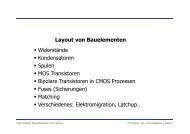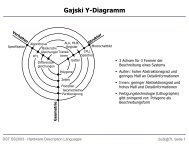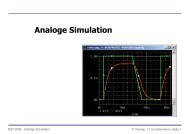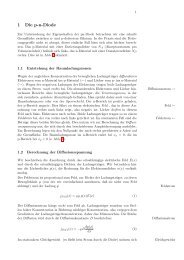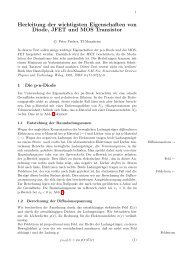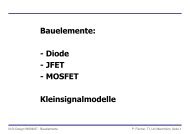Exercise 6: The MOS Transistor - Lehrstuhl für Schaltungstechnik ...
Exercise 6: The MOS Transistor - Lehrstuhl für Schaltungstechnik ...
Exercise 6: The MOS Transistor - Lehrstuhl für Schaltungstechnik ...
You also want an ePaper? Increase the reach of your titles
YUMPU automatically turns print PDFs into web optimized ePapers that Google loves.
<strong>Exercise</strong> 6:<br />
<strong>The</strong> <strong>MOS</strong> <strong>Transistor</strong><br />
Prof. Dr. P. Fischer<br />
<strong>Lehrstuhl</strong> für <strong>Schaltungstechnik</strong> und Simulation<br />
Uni Heidelberg<br />
CCS <strong>Exercise</strong>: <strong>MOS</strong> <strong>Transistor</strong><br />
© P. Fischer, ZITI, Uni Heidelberg Page1
<strong>Exercise</strong> 6.1: N<strong>MOS</strong> in Linear Region<br />
Use an N<strong>MOS</strong> transistor of type<br />
N_13_MM from library<br />
UMC_13_C<strong>MOS</strong> with W=L=1µm<br />
Connect<br />
• source and bulk to ground<br />
• the gate to 2 V<br />
Sweep the drain voltage from -0.1V to 0.1 V and oberve the<br />
current<br />
Calculate the resistivity of the channel<br />
Double W or L and simulate & calculate again.<br />
• Are the results as expected<br />
Now set the gate voltage to 0.6 V. What is different<br />
Now sweep the drain voltage from -1V to 1V. What<br />
happens for positive and negative voltages<br />
CCS <strong>Exercise</strong>: <strong>MOS</strong> <strong>Transistor</strong><br />
© P. Fischer, ZITI, Uni Heidelberg Page2
<strong>Exercise</strong> 6.2: Transconductance<br />
For an N<strong>MOS</strong> of W=L=1µm with V BS = 0, keep the drain at<br />
1.8 V and sweep the gate voltage from 0 to 1.8 V. This is<br />
the transfer characteristic of the <strong>MOS</strong>.<br />
• Observe the drain current<br />
• Plot the square root of the current. Do you find a straight line as<br />
expected<br />
• Plot the current in log scale. Can you see the subthreshold<br />
region<br />
• What is the transconductance at V GS = 1V<br />
Make a parametric sweep changing W from 0.18µm to 2µm<br />
• Is the current proportional to W<br />
Repeat this for a L-sweep<br />
Plot the transfer curve for two different values of V BS , for<br />
instance 0 V and -2 V<br />
CCS <strong>Exercise</strong>: <strong>MOS</strong> <strong>Transistor</strong><br />
© P. Fischer, ZITI, Uni Heidelberg Page3
<strong>Exercise</strong> 6.3: Output Characteristic, Saturation<br />
Now plot the output characteristic, i.e. ID as a function of<br />
V DS for a fixed V GS .<br />
• Can you see the linear region and the saturated region<br />
Extract the output resistance for instance for V GS =1.8V and<br />
V DS =1.8V.<br />
Make a parametric sweep of V GS (0..1.8V in 0.2V steps)<br />
• Observe how the current changes<br />
• Observe how the saturation voltage changes<br />
• Observe how the output resistance changes<br />
Now use two <strong>MOS</strong> with different W (for instance 0.5µm and<br />
2µm).<br />
• Search for gate voltages so that the currents for a given VDS<br />
(for instance for 1.8 V) are similar.<br />
• Compare the output characteristics<br />
CCS <strong>Exercise</strong>: <strong>MOS</strong> <strong>Transistor</strong><br />
© P. Fischer, ZITI, Uni Heidelberg Page4
<strong>Exercise</strong> 6.4: P<strong>MOS</strong><br />
Simulate tranfer and output characteristic for a P<strong>MOS</strong><br />
• Note that the source is now ‚on top‘<br />
• Gate and drain must be negative w.r.t. source<br />
Simulate in parallel a N<strong>MOS</strong> of same size.<br />
• Plot the drain current of N<strong>MOS</strong> and P<strong>MOS</strong> simultaneously.<br />
• How much is the difference<br />
CCS <strong>Exercise</strong>: <strong>MOS</strong> <strong>Transistor</strong><br />
© P. Fischer, ZITI, Uni Heidelberg Page5



